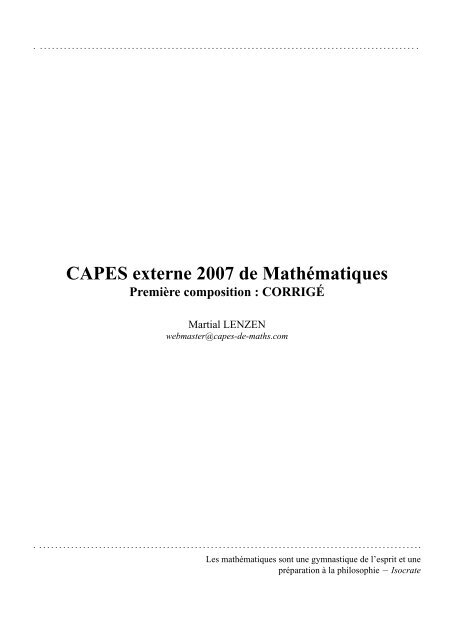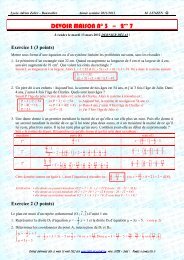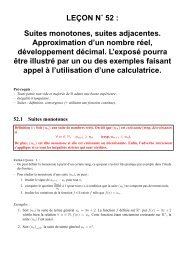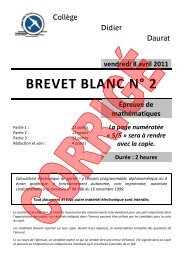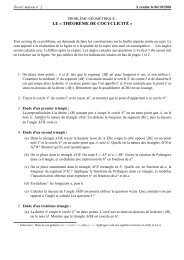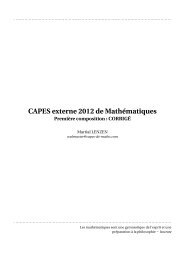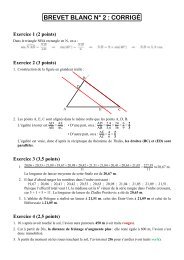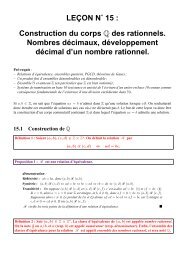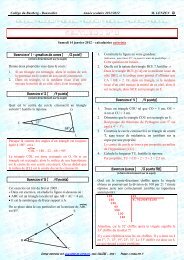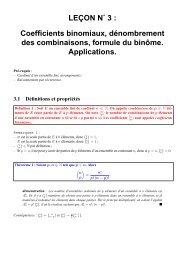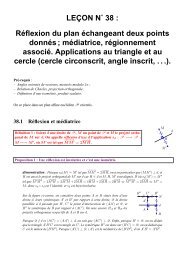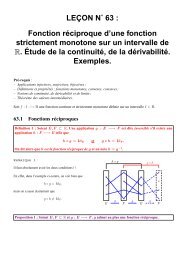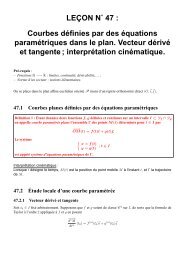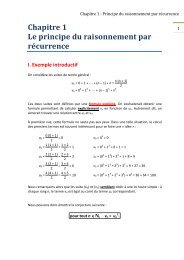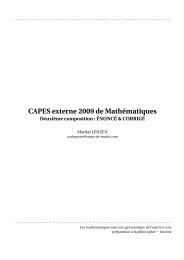You also want an ePaper? Increase the reach of your titles
YUMPU automatically turns print PDFs into web optimized ePapers that Google loves.
. . . . . . . . . . . . . . . . . . . . . . . . . . . . . . . . . . . . . . . . . . . . . . . . . . . . . . . . . . . . . . . . . . . . . . . . . . . . . . . . . . . . . . . . . . . . . . . .<strong>CAPES</strong> externe 2007 <strong>de</strong> MathématiquesPremière composition : CORRIGÉMartial LENZENwebmaster@capes-<strong>de</strong>-maths.com. . . . . . . . . . . . . . . . . . . . . . . . . . . . . . . . . . . . . . . . . . . . . . . . . . . . . . . . . . . . . . . . . . . . . . . . . . . . . . . . . . . . . . . . . . . . . . . . .Les mathématiques sont une gymnastique <strong>de</strong> l’esprit et unepréparation à la philosophie − Isocrate
2 <strong>CAPES</strong> 2007 : Première composition1 Convergence <strong>de</strong> la suite (s n )1.1 Première métho<strong>de</strong>a) Soit k 2 un entier. Alors1k − 1 − 1 k −(k − 1) 1= =k k(k − 1) k(k − 1) = 1k 2 − k .Or k 2 ⇒ k 2 − k k 2 . En passant à l’inverse, nous avons bien que1k 2 1k − 1 − 1 k .1k 2 − k 1 k 2 , c’est-à-direb) D’après ce calcul, nous pouvons dire que pour tout entier n ∈ N ∗ ,s n = 1+n∑k=21k 2 1+ 1+n∑k=21k − 1 − 1 k)+(1 − 1 2 1+1− 1 n = 2 − 1 n .( 12 − 1 3)+ ···+La suite (s n ) n1 est donc majorée, puisque s n 2 pour tout n 1.( 1n − 1 − 1 )nc) Pour montrer que cette suite converge, il suffit encore <strong>de</strong> démontrer qu’el<strong>le</strong> est monotone. Pour toutn 1, on an+1 n1s n+1 − s n = ∑k=1k 2 − 1∑k=1k 2 = 1(n+1) 2 0.Par suite, la suite (s n ) n1 est croissante. Etant <strong>de</strong> plus majorée, el<strong>le</strong> est convergente. Un majorant <strong>de</strong>sa limite est alors 2, puisque s n 2 pour tout n 1.1.2 Deuxième métho<strong>de</strong>a) Nous avons trois propriétés à démontrer :⋄ On a déjà démontré plus haut que la suite (s n ) n1 est croissante.⋄ Montrons que la suite (t n ) n1 est décroissante. Pour tout n 1, on at n+1 −t n = s n+1 + 1n+1 − s n − 1 n = 1(n+1) 2 − 1n(n − 1) = − 1n(n+1) 2 0.On en déduit donc <strong>le</strong> résultat recherché.⋄ Montrons enfin que <strong>le</strong>ur différence tend vers 0. Pour tout n 1, on aLe résultat est immédiat.t n − s n = s n + 1 n − s n = 1 n .
<strong>CAPES</strong> 2007 : Première composition 3Les suites (s n ) n1 et (t n ) n1 sont donc adjacentes.b) Il s’agit <strong>de</strong> trouver n ∈ N tel que t n − s n 10 −1 . Ort n − s n 10 −1 ⇔ 1 n 10−1 ⇔ n 10.Il suffit alors <strong>de</strong> calcu<strong>le</strong>r s 10 et t 10 pour avoir l’encadrement recherché :Comme <strong>le</strong> montre la capture d’écran <strong>de</strong>calculatrice ci-contre, on a bien1,54977 S 1,64977.1.3 Troisième métho<strong>de</strong>Soit f la fonction définie parLe graphique ci-<strong>de</strong>ssous est donné :f : R ∗ −→ R ∗t ↦−→ 1t 2.1y = 1t 21 2 3 ··· n − 2 n − 1 n1. Quel<strong>le</strong> est l’aire <strong>de</strong> la surface rouge ?2. Quel<strong>le</strong> est l’aire sous la courbe entre <strong>le</strong>s abscisses 1 et n ? On la note A (n).3. En déduire que la suite (s n ) n1 <strong>de</strong> terme généra<strong>le</strong>st majorée.4. Montrer que cette suite est croissante.5. En déduire qu’el<strong>le</strong> converge.s n =n∑k=11k 2
4 <strong>CAPES</strong> 2007 : Première compositionSolution :n 11. L’aire <strong>de</strong> la surface rouge vaut ∑k=2 k 2 .∫ n 12. A (n) =1 t 2 dt = 1 − 1 n .n 13. On en déduit que pour tout n 1, ∑k=2 k 2 1 − 1 n . D’oùn 1∑k=2 k 2 1 − 1 nn 1⇔ 1+ ∑k=2 k 2 1+1− 1 n⇔n 1∑k=1 k 2 2 − 1 n ⇔ s n 2 − 1 n ,et par suite, notre suite est bien majorée, par 2.4. Pour tout n 1, on s n+1 − s n = 1(n+1) 2 > 0, donc cette suite est strictement croissante.5. Toute suite croissante et majorée converge, donc notre suite (s n ) n1 est bien convergente.2 Utilisation <strong>de</strong> polynômes1. P s’écrit P(X) = a 0 + a 1 X + a 2 X 2 + ···+a n X n = a n (X − α 1 )···(X − α n ). En i<strong>de</strong>ntifiant <strong>le</strong>s coefficients<strong>de</strong>s polynômes, en particulier <strong>le</strong> coefficient <strong>de</strong> X n−1 , on trouvequi est la formu<strong>le</strong> recherchée.a n (−α 1 − α 2 − ··· − α n ) = a n−1⇔n∑i=1α i = − a n−1a n,2. (a) Pour démontrer cette égalité, nous avons besoin <strong>de</strong> la proposition c-<strong>de</strong>ssous, que nous allonsdémontrer :Proposition : Pour tout entier naturel n et tout réel x, on asin(nx) = Im ( (cosx+isinx) n) .démonstration : En effet,Im ( (cosx+isinx) n) = Im ( (e ix ) n)= Im(e inx ) par la formu<strong>le</strong> <strong>de</strong> Moivre= Im ( cos(nx)+isin(nx) ) = sin(nx).Puisque p ∈ N et ϕ ∈ R, nous allons appliquer ce résultat à x = ϕ et n = p, nous permettantd’utiliser la formu<strong>le</strong> du binôme <strong>de</strong> Newton pour avancer :sin ( (2p+1)ϕ ) = Im ( (cosϕ + isinϕ) 2p+1)[ 2p+1 ( )]2p+1= Im ∑ i j sin j (ϕ) cos 2p+1− j (ϕ) .j=0j
<strong>CAPES</strong> 2007 : Première composition 5Or pour tout va<strong>le</strong>ur paire <strong>de</strong> j, <strong>le</strong> terme i j est réel. Par conséquent, la partie imaginaire que l’onrecherche s’obtient en ne considérant que <strong>le</strong>s va<strong>le</strong>urs <strong>de</strong> j impaires :⎡⎤sin ( (2p+1)ϕ ) ( )= Im⎢2p+1⎣i j sin j (ϕ) cos 2p+1− j (ϕ) ⎥j⎦2k+1∈Ip∑k=02p+1∑j = 0|j impair( 2p+12k+ 1)signe(i 2k+1) cos 2p+1−(2k+1) (ϕ) sin 2k+1 (ϕ)= ∑( ) 2p+1= (−1) k cos 2p−2k (ϕ) sin 2k+1 (ϕ),2k+ 1où I = {1,3,5,...,2p+1}. Nous avons utilisé <strong>le</strong> changement <strong>de</strong> variab<strong>le</strong>s j = 2k + 1 après <strong>le</strong>second symbo<strong>le</strong> d’égalité. Le résultat est ainsi démontré.(b) Toujours pour tous n ∈ N et ϕ ∈ R, on a :sin ( (2p+1)ϕ ) p ( ) 2p+1= ∑(−1) k cos 2p−2k (ϕ) sin 2p+1−2p+2k (ϕ)k=02k+ 1p ( ) 2p+1= ∑(−1) k cos 2p−2k 1(ϕ)k=02k+ 1sin 2p−2k (ϕ) sin2p+1 (ϕ)= sin 2p+1 p ( ) 2p+1(ϕ) ∑(−1) k cotan 2p−2k (ϕ)k=02k+ 1= sin 2p+1 p ( ) 2p+1 (cotan(ϕ) ∑(−1) k 2 (ϕ) ) p−k .2k+ 1k=03. (a) Soit k ∈ {1,..., p}. Alors d’après ce qui précè<strong>de</strong>, on aP(γ k ) ==)) p−kp ( ) ( ( 2p+1kπ∑(−1) k cotan 2k=02k+ 12p+1( )kπsin (2p+1)2p+1 sin(kπ)( ) = ( ) = 0.kπkπsin 2p+1 sin 2p+12p+12p+1(b) Soit k ∈ {1,..., p}. Alors nous avons la succession d’implications suivantes :Or1 k p ⇔ π kπ pπ⇔π2p+1 kπ2p+1 pπ2p+1⇒ 0 < kπ2p+1 pπ2p+1 .p < 2p+12⇒p2p+1 < 1 2 ,(car 2p+1 > 0)
6 <strong>CAPES</strong> 2007 : Première compositiondonc on a fina<strong>le</strong>ment queDe plus, pour tout k ∈ {1,..., p − 1},1 k p ⇒ 0 < kπ2p+1 < π 2 .k < k+ 1⇒kπ (k+ 1)π
<strong>CAPES</strong> 2007 : Première composition 7(b) Soient p 1 et k ∈ {1,..., p}. Alors (en utilisant <strong>le</strong>s résultats <strong>de</strong> la question 3.c),0 < sinϕ < ϕ < tanϕ ⇔ 0 < cotanϕ < 1 ϕ < 1sinϕ ⇔ 0 < cotan2 ϕ < 1 ϕ 2 < 1sin 2 ϕ)⇒ ∀ k, 0 < cotan 2 ( kπ2p+1( kπ⇔ ∀ k, cotan 2 2p+1p ( ) kπ⇒ ∑ cotan 2
8 <strong>CAPES</strong> 2007 : Première composition3 Utilisation <strong>de</strong>s intégra<strong>le</strong>s <strong>de</strong> Wallis1. I 0 =∫ π201 dt = π 2et J 0 =∫ π20[ tt 2 3] π2dt =30= π324 .2. (a) Soient n ∈ N, u(t) = cos 2n+1 (t) et v(t) = sin(t). Ces <strong>de</strong>ux fonctions sont <strong>de</strong> classe C 1 , on peutdonc utiliser <strong>le</strong> théorème d’intégration par parties afin <strong>de</strong> calcu<strong>le</strong>r I n+1 , en utilisant u ′ (t) =−(2n+1)sin(t)cos 2n (t) et v ′ (t) = cos(t) :∫ π ∫2I n+1 = u(t)v ′ 2(t) dt = [u(t)v(t)] π π20− u ′ (t)v(t) dt0= (2n+1)∫ π20sin 2 (t)cos 2n (t) dt = (2n+1)= (2n+1)I n −(2n+1)I 2n+1⇔ (2n+2)I n+1 = (2n+1)I n ⇔ I n+1 = 2n+12n+2 I n.0∫ π20(1 − cos 2 (t) ) cos 2n (t) dt(b) Effectuons une récurrence pour montrer ce résultat :initialisation (n = 0) : La question 1 nous assure que <strong>le</strong>s <strong>de</strong>ux membres sont bien égaux à π/2.hérédité : Supposons l’hypothèse <strong>de</strong> récurrence (H.R.) vraie au rang n, et montrons qu’el<strong>le</strong>l’est toujours au rang n+1 :I n+12.b= 2n+1=(2n)! π4 n (n!) 2 2 = (2n+2)(2n+1)(2n+2) 22n+2 I n H.R. = 2n+12n+2( ) ( )2(n+1) ! π 2(n+1) !4(n+1) 2 4 n (n!) 2 2 = 4 n+1( (n+1)! ) 2On en déduit que pour tout entier naturel n, I n = (2n)!4 n (n!) 2 π2 .π2 .(2n)! π4 n (n!) 2 23. Soit n 1.(a) Une première intégration par parties utilisant <strong>le</strong>s fonctions u(t) = cos 2n (t) et v(t) = t <strong>de</strong> classeC 1 donne :∫I n = [t cos 2n 2(t)] π π ∫ π20+ 2n t sin(t)cos 2n−1 2(t) dt = 2n t sin(t)cos 2n−1 (t) dt.00Une secon<strong>de</strong> intégration par parties, en utilisant <strong>le</strong>s fonction U(t) = sin(t)cos 2n−1 (t) et v(t) =t 2 /2 <strong>de</strong> classe C 1 , donne :I n = 2n 2 [t2 sin(t)cos 2n−1 (t)] π 20− 2n 2∫ π2∫ π ∫ π2= n 2nt 2 sin 2 t cos 2n−2 2t dt − n t 2 cos 2n−2 t dt000t 2( 1 − 2n(sin 2 t) ) (cos 2n−2 t) dt∫ π ∫ π= 2n 2 2t 2 cos 2n−2 t dt − 2n 2 2t 2 cos 2n t dt − nJ n−10= (2n 2 − n)J n−1 − 2n 2 J n = n(2n − 1)J n−1 − 2n 2 J n .0
<strong>CAPES</strong> 2007 : Première composition 9(b) On aK n−1 − K n = 4n−1( (n − 1)! ) 2(2(n − 1))!J n−1 − 4n (n!) 2(2n)!⇔ K n−1 − K n = (2n − 1)(2n)4n−1( (n − 1)! ) 2 Jn−1 − 4 n (n!) 2 J n(2n)!⇔ (2n)! (K n−1 − K n ) = 4 n−1( (n − 1)! ) 2((2n − 1)(2n)Jn−1 − 4n 2 )J n⇔(2n)! (K n−1 − K n ) = 2 · 4 n−1( (n − 1)! ) 2 In⇔ (2n)! (K n−1 − K n ) = 2 · 4 n−1( (n − 1)! ) 2 (2n)! π4 n (n!) 2 2⇔K n−1 − K n = 4n−1( (n − 1)! ) 2 π4 n (n!) 2 = π4n 2.J n(c) Par suite, on aπ4n∑k=11k 2 = n∑k=1nπ4k 2 = ∑ K k−1 − K k = K 0 = K n = J 0 − K n .k=1En effet, la définition <strong>de</strong> K n pour tout entier naturel n nous permet d’affirmer que K 0 = J 0 .4. (a) Nous avons déjà démontré plus haut que tout x ∈]0,2 π[ vérifiait x < sinx.Or 2 π 1, donc x
10 <strong>CAPES</strong> 2007 : Première composition(c) On en déduit <strong>le</strong>s implications suivantes, amorcées par <strong>le</strong> théorème d’encadrement :lim K πn = 0 ⇒ limn→∞ n→∞ 4⇒n∑k=1S = lim n→∞n∑k=11k 2 = J 0 = π3241k 2 = π3244π = π26 .4 Noyau <strong>de</strong> Dirich<strong>le</strong>t1. Soient n 1 un entier et x ≢ 0 [2π] un réel. Alors2. Soit n 1 un entier.D n (x) = 1 n2 + ∑ cos(kx) = 1 nk=12 + ∑k=1= 1 2e ikx − e −ikxn∑k=−ne ikx = 1 2n2∑ (e ix ) −n (e ix ) kk=0= 1 2 (eix ) −n 1 −(eix ) 2n+11 − e ix = 1 2= 1 (e ix ) −n−1/2 −(e ix ) n+1/22 (e ix ) −1/2 −(e ix ) 1/2 = 1 2( (= 1 sin n+ 1 )x2)(2 x .sin2)2(e ix ) −n−1/2 1 −(e ix ) 2n+1(e ix ) −1/2 1 − e ix−2i sin ( (n+ 1 2 )x)−2i sin( x 2 )(a) 2.a. Soit k 1 un entier. En faisant une intégration par parties à l’ai<strong>de</strong> <strong>de</strong>s fonctions u(x) = x etv(x) = sin(kx)k<strong>de</strong> classe C 1 , nous obtenons :∫ π0xcos(kx) dx = 1 k [xsin(kx)]π 0 − 1 k∫ π0sin(kx) dx = 1 k 2 [cos(kx)]π 0 = (−1)k − 1k 2 .Nous remarquons que cette intégra<strong>le</strong> est nul<strong>le</strong> pour toute va<strong>le</strong>ur <strong>de</strong> k paire. On en déduit que :∫ π{ 0 si k est pair,xcos(kx) dx =0− 2 k 2 si k est impair.(b) Par conséquent,∫ π0xD n (x) dx =∫ π0= π24 + n∑k=1nx2 + x ∑ dx =k=1cos(kx) 1 2∫ π0xcos(kx) dx∫ π= π2 n4 + (−1)∑ k − 1k=1k 2 = π2 n4 − ∑k=10∫ πx dx+0n∑k=1xcos(kx) dx( l’échange <strong>de</strong>s symbo<strong>le</strong>s est possib<strong>le</strong>car la somme et l’intégra<strong>le</strong> sont finiesn1k 2 + (−1)∑ kk=1k 2 .)
<strong>CAPES</strong> 2007 : Première composition 113. Notons ̂f la fonction donnée dans l’énoncé. Il est clair que cette fonction est <strong>de</strong> classe C ∞ sur ]0,π[en tant que quotient <strong>de</strong> <strong>de</strong>ux fonctions <strong>de</strong> même classe. ̂f est donc en particulier <strong>de</strong> classe C 1 surcette interval<strong>le</strong>.Déterminons alors si ̂f admet une limite en 0 :xxsin(2 x) = 2 2Xsin(2 x) ⇒ lim ̂f(x) = 2 limx→0 X→0 sinX = 2.Nous pouvons désormais définir la fonction f sur [0,π] par{ ̂f(x) si x > 0,f(x) =2 si x = 0.Il ne reste plus qu’à vérifier que f est dérivab<strong>le</strong> en 0, et que f ′ y est continue. f est dérivab<strong>le</strong> sur ]0,π],et pour tout x <strong>de</strong> cet interval<strong>le</strong>, on af ′ (x) = sin( x 2 ) − x 2 cos( x 2 )sin 2 ( x 2 ) .On applique alors un développement limité <strong>de</strong> f ′ (x) lorsque x tend vers 0 afin d’obtenirf ′ (x) =x2 − 2 x + 16 x3 + o(x3 )x 24 + =o(x3 )x 316 + o(x3 ) xx 24 + o(x3 ) 0 4 .Il s’en suit que limx→0f ′ (x) = 0. Par <strong>le</strong> théorème <strong>de</strong> polongement <strong>de</strong> la dérivée, on peut enfin conclureque f est <strong>de</strong> classe C 1 sur [0,π], avec f ′ (0) = limx→0f ′ (x) = 0.4. On utilise une intégration par partie en utilisant <strong>le</strong>s fonctions u(x) = φ(x) et v(x) = − cos(λx)λ<strong>de</strong> classeC 1 sur [0,π] :∫ π0φ(x) sin(λx) dx =[− cos(λx) ] πφ(x) + 1 ∫ πλ0λ 0= φ(0)λ− cos(λπ)φ(π)λ+ 1 λφ ′ (x) cos(λ) dx∫ π0φ ′ (x) cos(λ) dxPuisque <strong>le</strong>s fonctions φ et φ ′ sont continues sur [0,π], il existe <strong>de</strong>ux réels m et M tels que pour toutx ∈ [0,π], m φ(x) M et m φ ′ (x) M. De plus, <strong>le</strong> cosinus est toujours compris entre −1 et 1.On en déduit donc que <strong>le</strong>s <strong>de</strong>ux premiers termes ci-<strong>de</strong>ssus ten<strong>de</strong>nt vers 0 lorsque λ tend vers l’infini,ainsi que <strong>le</strong> troisième puisque l’intégra<strong>le</strong> est bornée, d’où <strong>le</strong> résultat.5. (a) On a donc, en utilisant φ(x) = f(x),limλ → ∞∫ π0φ(x) sin(λx) dx = 0 ⇔ lim⇔⇔⇔∫ πn→ ∞ 0∫ π( (φ(x) sin n+ 1 2)xlim (n→ ∞ 0 x sinsin∫2)π2 lim x D n (x) dx = 0n→ ∞ 0lim L n = 0.n→ ∞( (n+ 1 2)x)x dx = 0)dx = 0
12 <strong>CAPES</strong> 2007 : Première composition(b) En poursuivant nos calculs, sachant que W = − π212 = − 2 1 S, on a :(lim L π 2 nn = 0 ⇔ limn→∞ n→∞ 4 − ∑k=1)n1k 2 + (−1)∑ kk=1k 2 = 0On retrouve ainsi la va<strong>le</strong>ur <strong>de</strong> S.⇔⇔π24− S+W = 0 ⇔π24 − S − 1 2 S = 0π24 = 3 2 S ⇔ S = 2π24 · 3 = π26 .5 Une somme doub<strong>le</strong>1. (a) Soit N 1 un entier. Nous allons utiliser, comme lors <strong>de</strong> la première partie, une comparaison àune intégra<strong>le</strong> :1y = 1 x1y = 1 x1 2 3 ··· N − 1 N N + 111 2 3 ··· N − 1 N N + 1L’aire rouge correspond à H N , et la b<strong>le</strong>ue à L’aire b<strong>le</strong>ue correspond aussi à H N , tandis∫ N∫dxN+11+1 x . Par conséquent, que l’aire sous la courbe vaut dx1 x .∫ N∫dxN+1H N 1+x . D’où dxx H N.1Nous avons donc∫ N+11∫dxNx H dxN 1+1 x⇔ln(1+N) H N 1+ln(N).(b) N étant un nombre positif, on peut diviser cette inégalité par N :ln(1+N)N H NN 1 N + ln(N)N .ln(1+N)Les croissances comparées à l’infini nous assurent que lim = 0 et limN→∞ Nc’est <strong>le</strong> théorème d’encadrement qui permet ainsi d’arriver au résultat attendu :H NlimN→∞ N = 0.N→∞ln(N)N= 0, et
<strong>CAPES</strong> 2007 : Première composition 13(c) Nous allons démontrer ce résultat par récurrence :Initialisation (M = 2) : Le membre <strong>de</strong> gauche vaut1 · 2 = 1 , et celui <strong>de</strong> droite vaut211 + 1 4 − H 22 = 5 4 − 1 (1+ 1 )= 1 2 2 2 .L’égalité est donc vérifiée pour M = 2.Hérédité : Supposons l’hypothèse <strong>de</strong> récurrence (HR) vraie au rang M, et montrons qu’el<strong>le</strong>l’est encore au rang M + 1 :M∑m=1H mm(m+1)====M−1∑m=1M∑m=1M∑m=1M+1∑m=1H mm(m+1) +1m 2 − H MM(1m 2 −1m 2 − H M+1M + 1 .H MH 1M(M + 1)(1 − 1 )=M + 1HR =M∑m=1)1H M+1M + 1 − M+1=M + 1M∑m=1M∑m=11m 2 − H MM +1m 2 −Nous avons ainsi démontré <strong>le</strong> résultat suivant : pour tout M 2 entier,M−1∑m=1H mm(m+1) = M∑m=11m 2 − H MM .H MM + 1H MM(M + 1)1m 2 − H M+1M + 1 + 1(M + 1) 2(d) Le premier terme du membre <strong>de</strong> droite converge lorsque M tend vers l’infini, <strong>de</strong> limite S. Lesecond converge aussi d’après la question b. On en déduit queM−1lim ∑M→∞m=1+∞H mm(m+1) = ∑m=1H mm(m+1) = S.2. Soient N un entier naturel non nul.(a) Soit m un entier quelconque, supérieur ou égal à 2. Nous allons faire une récurrence sur N.Initialisation (N = 1) : Par la définition <strong>de</strong> Z N,m , on a :Or(1m − 1H m−1 −m∑n=2Z 1,m =)1n(On a donc bien Z 1,m = 1m − 1==1∑n=1H m−1 −1n(n+m−1) = 1m − 1 .(1 m−1 m1m − 1∑n=1n − ∑n=21m − 1m∑n=21nm − 1m = 1 m .))1= 1 ( 1n m − 1 n − 1 )m, <strong>de</strong> sorte que <strong>le</strong> rang N = 1 soit vérifié.
14 <strong>CAPES</strong> 2007 : Première compositionHérédité : Supposons maintenant <strong>le</strong> résultat vrai au rang N, et montrons qu’il l’est encore aurang N + 1. Nous utiliserons la démonstration pour amorcer <strong>le</strong> raisonnement :Z N+1,m ===H.R.==N+1∑n=1N∑n=1N∑n=11m − 11m − 11n(n+m−1) = N∑n=11n(n+m−1) + 11n(n+m−1) + 1(N + 1) ( (N + 1)+m−1 )m − 1m − 1 (N + 1)(N + m)( 1N + 1 − 11n(n+m−1) + 1)m − 1 N + m()N+m−11H m−1 − ∑n=N+1n + 1N + 1 − 1N + m( ) (1H m−1 − = 1 H m−1 −n m − 1N+m∑n=N+2L’hyptohèse <strong>de</strong> récurrence est donc vraie au rang N + 1.Le résultat est donc démontré, et on a donc que pour tout entier m 2,()Z n,m = 11H m−1 − .m − 1nN+m−1∑n=N+1(N+1)+m−1∑n=(N+1)+21n).(b) Pour tout entier n strictement positif, n N + 1 > 0 ⇒ 0 < 1 n 1N + 1 . D’où0
<strong>CAPES</strong> 2007 : Première composition 15Nous avons du séparer <strong>le</strong> premier terme (correspondant à m = 1) <strong>de</strong> la somme car Z N,m n’est pasdéfini pour m = 1.(b) Les sommes étant finies, nous pouvons aussi échanger <strong>le</strong>s symbo<strong>le</strong>s ∑ et lim :lim Z N,m = H m−1N→∞ m − 1⇒MZ N,mlim ∑N→∞m=2d’où <strong>le</strong> résultat suivant (connaissant déjà S = limN Mlim ∑ ∑N→∞n=1 m=11nm(n+m−1) = limN→∞(N∑n=1Mm = ∑ limm=2N→∞N→∞ ∑N n=1 1 n 2 = π21n 2 + M∑m=2Z N,mmMZ N,mm = H m−1∑m=2m(m − 1) ,6 ) :)= π26 + M∑m=2H m−1m(m − 1) .(c) D’après 1.d, nous savons déjà queOn en déduit que(limM→∞N Mlim ∑ ∑N→∞n=1 m=1+∞∑m=1+∞H mm(m+1) = ∑m=2H m−1m(m − 1) = S.) (1π 2 M= limnm(n+m−1) M→∞ 6 + ∑m=2H m−1m(m − 1))= 2π26 = π23 .6 La fonction Dilogarithme1. Pour x ∈ [−1,1[−{0}, il n’y a pas <strong>de</strong> problème : la fonction dans l’intégra<strong>le</strong> est continue. De plus,ln(1 −t) est équiva<strong>le</strong>nt en 0 à 1 t, ce qui rend la fonction dans l’intégra<strong>le</strong> équiva<strong>le</strong>nte en 0 à −1, c’està-direprolongeab<strong>le</strong> par continuité, et el<strong>le</strong> est donc intégrab<strong>le</strong>.2. Notons ϕ la fonction ln définie sur R ∗ +. Alorsln(1 −t) ϕ(1 −t) − ϕ(1)lim = − lim= −ϕ ′ (1) = −1,t→1 tt→1 (1 −t) − 1donc l’intégra<strong>le</strong> impropre Li(x) existe bien en 1, et Li(1) = lim t→1 Li(x).3. (a) Soit x ∈ ] − 1,1[. Posons f(x) =Nous avons alors+∞∑n=1∀ x < |1|, ln(1+x) =⇒f ′ (x) =f(x) = −x n. Rappelons avant tout quen2 +∞∑(−1) n xn+1n=0n+1+∞∑n=1∫ x0x n−1n = −1 xln(1 −t)t⇒ln(1 − x)⇔ f(x) = Li(x) ⇒ Li(x) =dtln(1 − x) = −+∞x∑nn=1n 2.+∞∑n=1x nn .
16 <strong>CAPES</strong> 2007 : Première composition(b) Par conséquent,+∞x→1∑n=1Li(1) = lim Li(x) = limx→1x n +∞n 2 = ∑n=11n 2 = π26 .4. (a) Soit x ∈ ]0,1[. On rappel<strong>le</strong> que pour <strong>de</strong>ux fonctions f et g dérivab<strong>le</strong>s, on peut avoir( f ◦ g) ′ (x) = ( f ′ ◦ g)(x)g ′ (x).Cette formu<strong>le</strong> peut être appliquée ici car la fonction x ↦−→ 1 − x renvoie un nombre lui aussistrictement compris entre 0 et 1. Par suite,()( ) ′ Li(x)+ Li(1 − x) = Li ′ (x)+ Li ′ ln(1 − x) ln(1 −(1 − x))(1 − x) = − + − (−1)x1 − x= ln(x)1 − xln(1 − x)− .x(b) Posons, pour tout x ∈ ]0,1[, g(x) = −ln(1 − x)ln(x). Soit x ∈ ]0,1[. Alors( )−1g ′ (x) = −1 − x ln(x)+ln(1 − x)1 = ln(x) ln(1 − x)− .x 1 − x xPar suite, g ′ (x) = ( Li(x) + Li(1 − x) ) ′ , donc Li(x) + Li(1 − x) = g(x) + C, où C est uneconstante que l’on va déterminer.En faisant tendre x vers 0, on trouve que lim Li(x) = 0, lim Li(x) = π2. De plus,x→0 x→0 6e g(x) = e −ln(x)ln(1−x) = (1 − x) −ln(x) −−→x→01,donc limx→0g(x) = 0. On en déduit directement queC = π26 .5. Appliquons la formu<strong>le</strong> précé<strong>de</strong>nte au réel x = 1 2 :( ( )12 Li =2) π2 16 − ln2 2⇔ 2⇔+∞∑n=1+∞∑n=112 n n 2 = π26 − ln2 (2)12 n n 2 = π212 − ln2 (2).26. (a) Soit x ∈ ] − 1,1[. Nous avons :(( ) ′ ln(1 − x)Li(x)+ Li(−x) = − + − ln(1+x) )(−1)x−xln(1 − x) − ln(1+x)= −x= − ln(1 − x2 ).x
<strong>CAPES</strong> externe 2007 : Première composition 17De plus,( ) 1 ′2 Li(x2 ) = 1 (− ln(1 − )x2 )2 x 2 (2x)= − ln(1 − x2 ).xCes <strong>de</strong>ux dérivées sont éga<strong>le</strong>s, nousen déduisons donc queLi(x)+Li(−x) = 1 2 Li(x2 = +C,avec C une constante que l’on détermine en remplaçant x par 0 dans <strong>le</strong>s <strong>de</strong>ux membres. PuisqueLi(0) = 0, on trouve C = 0, et <strong>le</strong> résultat s’en suit.(b) Dans cette égalité, il suffit alors <strong>de</strong> faire tendre x vers 1 afin <strong>de</strong> trouver1lim Li(x)+Li(−x) = limx→1 x→1 2 Li(x2 ) ⇔ π2 +∞6 + ∑⇔n=1(−1) nn 2 = 1 2π 26+∞(−1)∑nn=1n 2 = − 1 π 22 6 = −π212 .7. (a) Dérivons <strong>le</strong> membre <strong>de</strong> gauche. On trouve pour tout réel x ∈ ]0,1[ :(( 1 − xLi(x) − Li(−x)+Li1+x(− − ln(1+x)xln(1 − x)= −x= 1 x ln ( 1+x1 − x)+ 2= ( ln(x) ) ′ ln( 1+x1 − x1 − x 2 lnx)+ lnx)− Li( )) x − 1 ′1+x)+ 21 − x 2 ln ( 2x1+x(ln( 1+x) ) ′.1 − x)− 2 ( ) 21 − x 2 ln 1+xPar intégration, on en déduit queLi(x) − Li(−x)+Li( ) 1 − x− Li1+x( ) x − 1= ln1+x( ) 1+xlnx+C,1 − xavec C une constante que l’on détermine en faisant tendre x vers 0 dans <strong>le</strong>s <strong>de</strong>ux membres.Puisque Li(0) = 0, on obtient :On trouve bien <strong>le</strong> résultat <strong>de</strong>mandé.Li(1) − Li(−1) = C ⇔ C = π26 + π212 = π24 .
18 <strong>CAPES</strong> externe 2007 : Première composition(b) Appliquons la formu<strong>le</strong> précé<strong>de</strong>nte au cas particulier x = √ 2 − 1 ∈ ]0,1[. On trouve :Li( √ 2 − 1) − Li(1 − √ (2 − √ ) (√ ) ( √ )2 2 − 22)+Li √ − Li √ = π2 22 2 4 + ln 2 − √ ln( √ 2 − 1)2⇔ Li( √ 2 − 1) − Li(1 − √ 2)+Li( √ 2 − 1) − Li(1 − √ ( √ )2) = π2 √2 2+14 + ln √ ln( √ 2 − 1)22 − 1 2⇔6.3.a⇔⇔2 ( Li( √ 2 − 1) − Li(1 − √ 2) ) = π24 + ln(√ 2+1)ln( √ 2 − 1)( √ 2 − 1) k (1 − √ 2) kk 2 −k 2 = π28 + 1 2 ln(√ 2+1)ln( √ 2 − 1)+∞∑k=1+∞∑k=1+∞( √ 2 − 1)∑kk=1k 2 + (−1)k (1 − √ 2) kk 2= π28 + 1 2 ln(√ 2+1)ln( √ 2 − 1).Lorsque k est pair, chaque terme <strong>de</strong> la somme est nul. La somme peut donc se faire uniquementsur <strong>le</strong>s k impairs. En posant k = 2n+1, on trouve fina<strong>le</strong>ment que+∞( √ 2 − 1)∑2n+1n=0(2n+1) 2 = π28 + 1 2 ln(√ 2+1)ln( √ 2 − 1).


